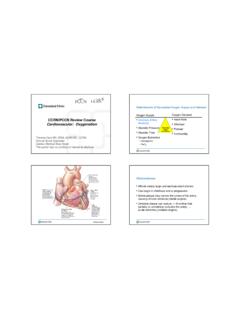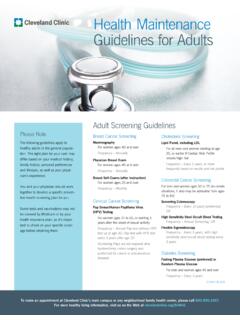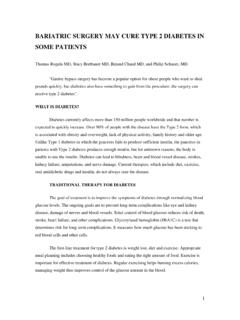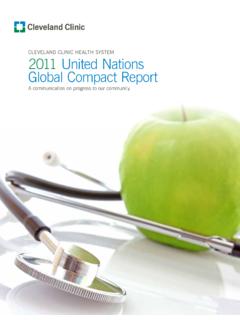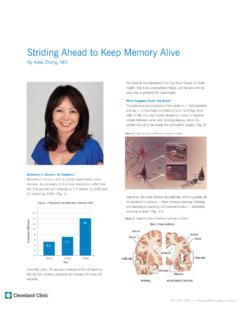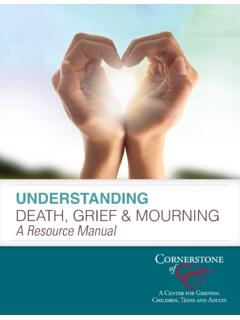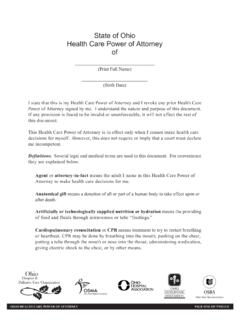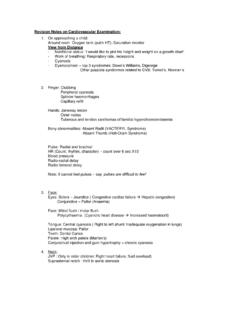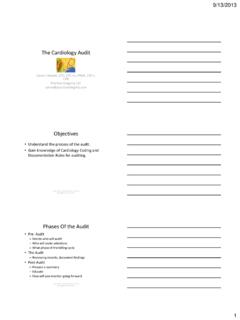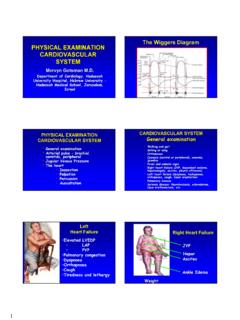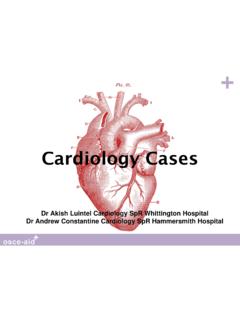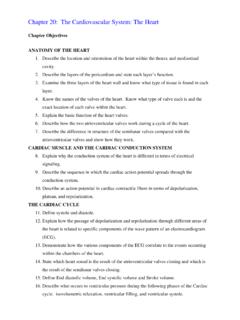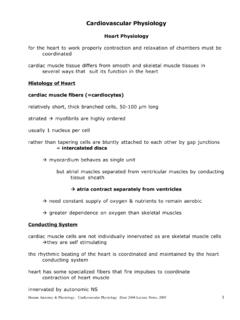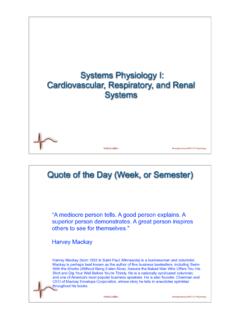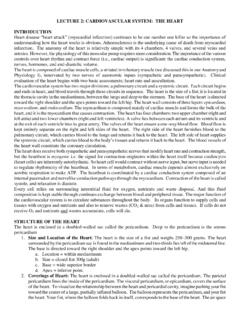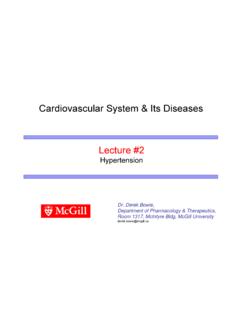Transcription of CCRN Review Course Cardiac Surgery - Cleveland Clinic
1 1 ccrn Review CourseCardiac SurgeryMyra Cook MSN, RN, ACNS-BC, ccrn -CSCC linical Nurse Specialist cardiovascular Intensive Care Unit The author has no conflict of interest to discloseCCRN/PCCN Review CourseCardiac Surgery2 Indications (partial list) Angina + LMCA stenosis Left main stenosis> 70% Proximal LAD stenosis with 1 or 2-vessel disease Proximal LAD > 70% + proximal Cx Triple vessel, EF < 50% Angina + 2-vessel disease, LAD stenosis, EF < 50% Ruptured papillary muscle, VSD, LV rupture Failed PCI w/ hemodynamic instabilityEagle KA, Guyton RA,Davidoff R, Edwards FH, Ewy GA, Gardner TJ, Hart JC, Herrmann HC, HillisLD, Hutter AM Jr, Lytle BW, Marlow RA, Nugent WC, Orszulak TA. ACC/AHA 2004 guideline update for coronary artery bypass graft Surgery : a report of the American College of Cardiology/American Heart Association TaskForce on Practice Guidelines.
2 American College of Cardiology WebSite. Available at: Surgery +Artery+Bypass+Graft&aid=5029227#5029243 3 Conduits Saphenous vein Poor lung function Occluded subclavian artery Hx chest radiation Hx bilateral mastectomy4 Conduits Internal mammary artery Diabetes Obesity RCA or LAD lesion Saphenous unavailable Atherosclerotic aorta25 Radial artery graft Gastroepiploic graft6 Conduits: PatencyVenous Conduits 90% at 1 year 50-60% at 10 years 20% at 20 years 80% at 10 years with SV to LADI nternal mammary artery 95% at 1 year 90% at 10 yearsBourassa et al. Circulation1982 Lytle et al. JTCVS1985 Zeff et al. Ann Thorac Surg1988 90% at 20 years7 Cardiopulmonary Bypass Hypothermia Systemic cooling (28 C to 30 C) Topical cooling Infusion of chilled cardioplegia Reduced metabolic and oxygen demands organ preservation Cardioplegia Contains an ingredient (usually K+) to depolarize cell membrane arrests heart during diastole Myocardial preservation Hemodilution Crystalloid solution Decrease blood viscosity improved blood flow Decrease hemolysis Usually to Hct of 25% to 30% Anticoagulation Heparin (antidote is Protamine)
3 Prevents clot formation8 Effects of Cardiopulmonary Bypass Hemolysis Platelets, RBCs, WBCs & plasma proteins Damaged in pump circuit Coagulopathy Activation of clotting factors Electrolyte imbalance Pump priming solutions, fluid shifts, IV fluids Hyperglycemia Stress Response Edema Inflammatory response capillary permeability Neurologic dysfunction Inadequate cerebral perfusion, micro emboli to brain (air, plaque, blood)39 CABG: Proven Strategies to Prevent Perioperative Mortality/Morbidity Preoperative Carotid screening Perioperative Prophylactic antimicrobial therapy Antiarrhythmics (beta blockers) Postop Antiplatelet therapy (aspirin) Lipid-lowering therapy (statins) Smoking cessationCABGT reatmentGuidelinesACCAHA2005 ccrn Review CourseCardiac SurgeryMyra Cook MSN, RN, ACNS-BC, ccrn -CSCC linical Nurse Specialist cardiovascular Intensive Care Unit The author has no conflict of interest to discloseValvular Heart 12 Valvular Heart Disease: Etiologies Congenital Malformation ( bicuspid aortic valve) Connective Tissue Disorders Marfan s syndrome Ehlers-Danlos syndrome Barlow s Syndrome (mitral valve prolapse)413 Valvular Heart Disease.
4 Etiologies Acquired Rheumatic Heart Disease Group A Streptococcal Endocarditis ( bacterial, viral, fungal) Myocardial Infarction Aortic dissection/aneurysm Cardiomyopathies Heart Failure Blunt/penetrating Trauma Degeneration (calcification, fibrosis)14 Valvular Heart Disease: Terminology Stenosis- impeded forward flow through an opened valve Regurgitation- backward leaking of blood through a closed valve Vegetation- abnormal growth/lesions on diseased heart valves ( endocarditis), comprised of fibrin, platelets, RBCs, necrotic tissue, and bacteria Calcification- build-up of calcium deposits on valve leaflets, causing narrowing of opening ( stenosis)15 Chest Examination Points Aortic: 2 ICS, RSB Pulmonic: 2 ICS, LSB Tricuspid: 5 ICS, LSB Mitral (apical): 5 ICS, MCL Erb s Point: 3 ICS, LSB Epigastric: over xiphoid 517 Murmurs Stenosis: occurs when valves are supposed to be open Diastole: mitral, tricuspid Systole: aortic, pulmonic Regurgitation: occurs when valves are supposed to be closed Diastole: aortic, pulmonic Systole: mitral, tricuspid18 Causes of Murmurs High rate of blood flow through a normal structure Normal blood flow through a narrowed structure Back flow of blood through an incompetent structure Turbulent blood flow in an enlarged, dilated structure19 Valvular Heart Disease.
5 MurmursSystolic Murmur Mitral Regurgitation Prolapse/pansystolic Aortic Stenosis SystolicDiastolic Murmur Mitral S tenosis A ortic Regurgitation D iastolic*Note: Ventricular septal rupture (VSD) Holo(pan)systolic murmur20 Valvular Heart Disease: Signs and Symptoms Decreased Cardiac output: Fatigue Palpitations Dizziness Pulmonary congestion Shortness of breath/dyspnea Murmur Extra heart sounds (S3 and/or S4) S/S of heart failure Dysrhythmias Elevated filling pressures (CVP, PAP, PAOP) Angina/chest discomfort621 Management of Valve Disease Oxygenation Hemodynamic stability Decrease preload Decrease afterload Increase contractility Treat dysrhythmias Anticoagulation Antibiotic prophylaxis prior to invasive/dental procedure Balloon valvuloplasty Cardiac rehab Surgical repair/replacement22 Valve Surgery : repair vs.
6 Replace23 Valvular Heart Disease Types of Surgery :1)Reconstructivea)Open commissurotomyb)Valvuloplastyc)Annulopla sty2)Valve replacementa)Mechanical b)Biological tissue (pigs - porcine, cows - bovine, human cadaver homographs)24 Valve Replacement Mechanical Tilting disc Bileaflet Biologic Porcine Bovine Allograft (cadaver)725 Mechanical Prosthetic Valves:Advantages: Durability Good hemodynamicsDisadvantages: Lifetime anticoagulation Audible click Mechanical failure Infections are harder to treat26 Biological Tissue Valves:Advantages: Non-thrombogenic No long-term anti-coagulation Good hemodynamics Quiet Infections are easier to treatDisadvantages: Prone to deterioration Frequent replacement is required (average of 10 years)27 Valve Replacement Complications Inadequate seating Thromboembolism Endocarditis28 Post Open Heart Surgery -Complications Bleeding Infection Hemodynamic instability Stroke Dysrhythmias *VAP, pleural effusion Graft occlusion/stenosis Cardiac Tamponade/ Cardiogenic Shock829 Post Open Heart Surgery -ComplicationsCardiac Tamponade Occurs when fluid (blood, effusion fluid, pus) accumulates in the pericardial space compromising Cardiac filling and Cardiac output Pericardium typically has 20-50cc of blood30 Clinical Signs of Cardiac Tamponade Beck s Triad Hypotension Distended neck vein (JVD)
7 Muffled heart sounds Narrowed pulse pressure Tachycardia (usually) but may be PEA Dyspnea Peripheral pulses weak or absent Signs of shock (cool/clammy extremities, cyanosis)31 Hemodynamics of Cardiac Tamponade Increased CVP, PAD, PAOP Equalization of CVP, PAD, PAOP Decreased CO/CI Pulsus paradoxus32 Management of Cardiac Tamponade Post open heart Surgery : reopen chest Identify and treat cause Oxygenation (avoid high levels of peep) Volume expansion with blood, saline or plasma to maintain intravascular volume Inotropic therapy ( dobutamine) Bed rest with leg elevation (may venous return) Pericardial effusion pericardiocentesis, pericardial window933 Post Open Heart Surgery -ComplicationsCardiogenic shock Loss of myocardial contractile function to the extent that blood to the tissues to maintain aerobic metabolism becomes inadequate34 Clinical Signs of Cardiogenic Shock Restless and/or confused Cool, moist skin Hypothermia Rapid pulse Low BP UO<20 cc Rales Pulmonary edema35 Hemodynamics of Cardiogenic Shock Low CO syndrome SBP<90 CVP>9 PAWP>18 CI< SVR>200036 Management of Cardiogenic shock Oxygen Optimize CO/CI Reduce afterload (vasodilators, ACE-I) Improve contractility (Inotropic agents dobutamine, milirinone) Decrease preload (diuretics, vasodilators)
8 IABP Therapy Ventricular assist device1037 IABP Indications Failure to wean from cardiopulmonary bypass Cardiogenic shock Heart failure Acute heart attack Support during high-risk PCI 38 Trivia Question!!At what point in the Cardiac cycle does the heart muscle receive its blood supply? A. During systole B. During diastoleExplain your answer39 Diastole: IAB Inflation Increase myocardial oxygen supply Balloon inflation in diastole (aortic valve closure)Courtesy Datascope40 Systole: IAB Deflation Afterload reduction: Balloon deflation at end-diastole Reduce myocardial oxygen demand in systoleCourtesy Datascope1141 Courtesy Datascope42 IABP TherapyBenefits Increases coronary artery perfusion! Decreases afterload (SVR)!
9 Increases Cardiac output Increases MAPCCRN Review CourseCardiac SurgeryMyra Cook MSN, RN, ACNS-BC, ccrn -CSCC linical Nurse Specialist cardiovascular Intensive Care Unit The author has no conflict of interest to discloseCardiomyopathies44 Types of Cardiomyopathies Dilated Hypertrophic Restrictive Ischemic1245 Cardiomyopathy Diffuse dilation of atrias and ventricles Unknown/various causes Systolic dysfunction = Cardiac output S/S of heart failure: pulmonary/systemic congestion S/S: murmurs from MVR, TVR (systolic murmurs)47 Dilated Cardiomyopathy Treatment Diuretics: decrease preload Vasodilators: decrease afterload ( NTG, Nipride, ACE inhibitors) Inotropes: increase contractility (dobutamine, dopamine, epinephrine, digoxin)48 Hypertrophic Cardiomyopathy Asymmetrical hypertrophy of the LV with septal enlargement Creates diastolic stiffness/ impaired filling Inherited/idiopathic, neuromuscular disorders S/S: fainting, CP, lightheadedness during or after exercise, palpitations, dyspnea, SCD S/S: systolic murmur (AS, MR), S3/S4 1349 Hypertrophic CardiomyopathyTreatment: Beta blockers, calcium channel blockers, volume, antiarrhythmics, anticoagulants, alcohol ablation, myectomy Avoid.
10 Inotropes, nitrates, vasodilators, dehydration, strenuous exercise50 Restrictive Cardiomyopathy Most commonly caused from amyloidosis or idiopathic myocardial fibrosis Fibrous tissue infiltrates layers of heart Heart becomes noncompliant: can t relax or contract well Stiff ventricle: CO, pulmonary/systemic congestion S/S of right and left heart failure 51 Restrictive CardiomyopathyTreatment: Treat cause ACE inhibitors, beta-blockers, vasodilators, diuretics, AV sequential pacing, heart transplant52 Ischemic Cardiomyopathy Most common type of cardiomyopathy in the US Decreased pumping ability r/t coronary artery disease Not enough oxygen and blood to heart MI, angina, unstable angina S/S: Angina, pulmonary/systemic congestion, arrythmias1453 Ischemic CardiomyopathyTreatment: Focused on symptom management of HF Pharmacologic: ACE Inhibitors, beta blockers, diuretics Non-pharmacologic: Na restriction diet, lifestyle changes May need CABG or angioplasty May need pacemaker/AICD54 Practice Question An example of systolic murmur wo
